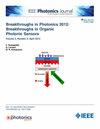Predicting the Evolution of the Supercontinuum Generation With CNN-LSTM Model
IF 2.1
4区 工程技术
Q3 ENGINEERING, ELECTRICAL & ELECTRONIC
引用次数: 0
Abstract
We propose a hybrid deep learning model, namely convolutional neural network–long short-term memory (CNN-LSTM) approach to investigate the evolution of the supercontinuum (SC) generation numerically. The hybrid model can use the CNN model to extract and map the local features of the sequence, followed by the LSTM to predict the overall trend of the SC generation. With the trained model by learning the propagation dynamics of the generalized nonlinear Schrödinger equation, the consistent outcome for the neural network predictions and numerical solutions has been obtained. The combined neural network can effectively solve the complex nonlinear propagation problems and maintain high accuracy compared with the LSTM, GRU neural networks for different incident power. The hybrid approach can facilitate the design and optimization of the spectral or temporal intensity distribution of SC generation, and may offer guidance for designing SC source for specific applications.用CNN-LSTM模型预测超连续统生成演化
我们提出了一种混合深度学习模型,即卷积神经网络-长短期记忆(CNN-LSTM)方法来数值研究超连续统(SC)生成的演化。混合模型可以使用CNN模型提取和映射序列的局部特征,然后使用LSTM预测SC生成的整体趋势。通过学习广义非线性Schrödinger方程的传播动力学,得到了神经网络预测结果与数值解一致的模型。与LSTM、GRU神经网络相比,该组合神经网络能有效解决复杂的非线性传播问题,并在不同的入射功率下保持较高的精度。这种混合方法可以方便地设计和优化SC产生的光谱或时间强度分布,并可为特定应用的SC源设计提供指导。
本文章由计算机程序翻译,如有差异,请以英文原文为准。
求助全文
约1分钟内获得全文
求助全文
来源期刊

IEEE Photonics Journal
ENGINEERING, ELECTRICAL & ELECTRONIC-OPTICS
CiteScore
4.50
自引率
8.30%
发文量
489
审稿时长
1.4 months
期刊介绍:
Breakthroughs in the generation of light and in its control and utilization have given rise to the field of Photonics, a rapidly expanding area of science and technology with major technological and economic impact. Photonics integrates quantum electronics and optics to accelerate progress in the generation of novel photon sources and in their utilization in emerging applications at the micro and nano scales spanning from the far-infrared/THz to the x-ray region of the electromagnetic spectrum. IEEE Photonics Journal is an online-only journal dedicated to the rapid disclosure of top-quality peer-reviewed research at the forefront of all areas of photonics. Contributions addressing issues ranging from fundamental understanding to emerging technologies and applications are within the scope of the Journal. The Journal includes topics in: Photon sources from far infrared to X-rays, Photonics materials and engineered photonic structures, Integrated optics and optoelectronic, Ultrafast, attosecond, high field and short wavelength photonics, Biophotonics, including DNA photonics, Nanophotonics, Magnetophotonics, Fundamentals of light propagation and interaction; nonlinear effects, Optical data storage, Fiber optics and optical communications devices, systems, and technologies, Micro Opto Electro Mechanical Systems (MOEMS), Microwave photonics, Optical Sensors.
 求助内容:
求助内容: 应助结果提醒方式:
应助结果提醒方式:


